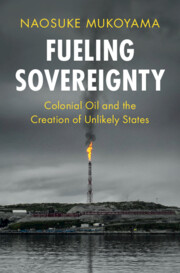617 results
31 - Two-Spirit Writers and Queer Native American Literature
- from Race and the Politics of Queer and Trans Representation
-
-
- Book:
- The Cambridge History of Queer American Literature
- Published online:
- 17 May 2024
- Print publication:
- 06 June 2024, pp 581-598
-
- Chapter
- Export citation
2 - Theory, Methods, and International Organizations
-
- Book:
- International Organizations
- Published online:
- 17 May 2024
- Print publication:
- 06 June 2024, pp 17-43
-
- Chapter
- Export citation
9 - Crime, Redress and Social Control
-
-
- Book:
- The Cambridge Comparative History of Ancient Law
- Published online:
- 09 May 2024
- Print publication:
- 30 May 2024, pp 446-511
-
- Chapter
- Export citation
3 - The Authority to Punish
-
- Book:
- The Right to Punish
- Published online:
- 16 May 2024
- Print publication:
- 23 May 2024, pp 47-74
-
- Chapter
- Export citation
Introduction
-
- Book:
- States-in-Waiting
- Published online:
- 09 May 2024
- Print publication:
- 16 May 2024, pp 1-26
-
- Chapter
-
- You have access
- Open access
- HTML
- Export citation
7 - Postcolonial Imperialism
- from Part III - The Boundaries of Decolonization
-
- Book:
- States-in-Waiting
- Published online:
- 09 May 2024
- Print publication:
- 16 May 2024, pp 203-229
-
- Chapter
-
- You have access
- Open access
- HTML
- Export citation
11 - The Chacay Massacre
-
-
- Book:
- Mobility and Coercion in an Age of Wars and Revolutions
- Published online:
- 09 May 2024
- Print publication:
- 16 May 2024, pp 235-257
-
- Chapter
-
- You have access
- Open access
- HTML
- Export citation
Weak sovereignty and interstate war
-
- Journal:
- International Theory , First View
- Published online by Cambridge University Press:
- 16 May 2024, pp. 1-25
-
- Article
-
- You have access
- Open access
- HTML
- Export citation
Chapter 19 - Forsaking Tradition: Dislocating the Sovereignty of Argentine Literature
- from Part II - Critical Inroads
-
-
- Book:
- A History of Argentine Literature
- Published online:
- 09 May 2024
- Print publication:
- 16 May 2024, pp 286-307
-
- Chapter
- Export citation
1 - Foundations of the Energy–Environment Nexus and International Economic Law
-
- Book:
- Energy and the Environment
- Published online:
- 30 April 2024
- Print publication:
- 02 May 2024, pp 12-56
-
- Chapter
- Export citation
Chapter 4 - Power and the Citizen
-
- Book:
- Freedom and Power in Classical Athens
- Published online:
- 04 April 2024
- Print publication:
- 11 April 2024, pp 88-135
-
- Chapter
- Export citation
3 - Revolutionary Republicanisms
-
- Book:
- Sharing Freedom
- Published online:
- 28 March 2024
- Print publication:
- 04 April 2024, pp 104-140
-
- Chapter
- Export citation
The Clinical Gaze of Lurianic Kabbalah
-
- Journal:
- Harvard Theological Review / Volume 117 / Issue 2 / April 2024
- Published online by Cambridge University Press:
- 15 May 2024, pp. 268-292
- Print publication:
- April 2024
-
- Article
- Export citation
1 - Introduction
-
- Book:
- Fueling Sovereignty
- Published online:
- 14 March 2024
- Print publication:
- 21 March 2024, pp 1-26
-
- Chapter
- Export citation
3 - Excavating the Territory of International Law
-
- Book:
- The Rebirth of Territory
- Published online:
- 07 March 2024
- Print publication:
- 14 March 2024, pp 71-142
-
- Chapter
- Export citation
5 - Reterritorialising International Law
-
- Book:
- The Rebirth of Territory
- Published online:
- 07 March 2024
- Print publication:
- 14 March 2024, pp 190-248
-
- Chapter
- Export citation

Fueling Sovereignty
- Colonial Oil and the Creation of Unlikely States
-
- Published online:
- 14 March 2024
- Print publication:
- 21 March 2024
1 - Introduction
-
-
- Book:
- States, Firms, and Their Legal Fictions
- Published online:
- 29 February 2024
- Print publication:
- 07 March 2024, pp 1-22
-
- Chapter
-
- You have access
- HTML
- Export citation
‘Sovereignty is still the name of the game’: Indigenous theorising and strategic entanglement in Māori political discourses
-
- Journal:
- Review of International Studies , First View
- Published online by Cambridge University Press:
- 21 February 2024, pp. 1-20
-
- Article
-
- You have access
- Open access
- HTML
- Export citation
7 - Beyond the State: Can State Law Survive in the Twenty-First Century?
-
-
- Book:
- The Cambridge History of Latin American Law in Global Perspective
- Published online:
- 15 January 2024
- Print publication:
- 08 February 2024, pp 485-541
-
- Chapter
-
- You have access
- Open access
- HTML
- Export citation



